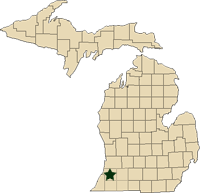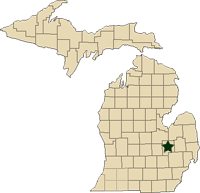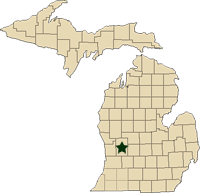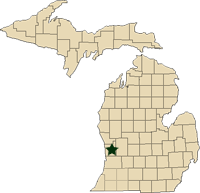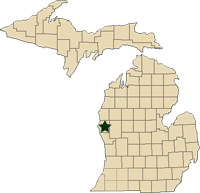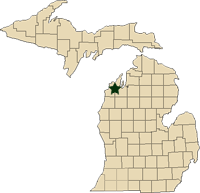Regional reports on Michigan fruit – July 26, 2011
MSU Extension educators’ pest and fruit updates for Michigan
This week’s regional reports:
- Southwest Michigan - Mark Longstroth, Bill Shane, Diane Brown
- Southeast Michigan - Bob Tritten
- Grand Rapids Area Tree Fruit - Amy Irish Brown and Phil Schwallier
- Grand Rapids Area Small Fruit – Carlos García-Salazar
- West Central Michigan - Mira Danilovich
- Northwest Michigan - Nikki Rothwell, Duke Elsner, Erin Lizotte
Southwest Michigan – Mark Longstroth, Bill Shane, Diane Brown, Michigan State University Extension
|
July has been hot with highs generally in the 80s. Last week was hot! Highs rose into the 90s and high humidity levels made it very uncomfortable. There were frequent scattered thunderstorms across the region last week. These storms dropped varying amounts of rain. Weekly precipitation totals varied from 1 to 3 inches. The heaviest rains were in the lower tier of counties and close to Lake Michigan. This amount of water is enough to maintain soil moisture. Soil moisture levels vary widely due to the high heat and uneven rainfall, but soils are generally moist. Soil temperatures are as warm as the air temperatures. Conditions for the upcoming week are forecast to be similar to last week, with rain most likely Wednesday and Thursday (July 27-28). The hot summer has the region only about a day behind normal for heat accumulation. Find the closest weather station near you at Enviro-weather.
|
Southwest Michigan Growing Degree Day Totals from March 1 through July 24 |
|||
|
Location |
GDD 42 |
GDD 45 |
GDD 50 |
|
2329 |
2017 |
1543 |
|
|
2165 |
1867 |
1412 |
|
Tree fruit
Cherry fruit flies and apple maggots are out. Japanese beetles are easy to find in favored feeding sites. The second generation of oriental fruit moth is flying and laying eggs. Potato leafhopper damage can be found in many crops. San Jose scale moth catch has increased over the last two weeks, signaling the start of the second generation. Crawlers from this generation are expected approximately 500 degree days base 51°F from the start of the flight. This is the generation that generally causes the most damage to fruit and trees.
In peaches, harvest of Early Star, Desiree and PF5D Big is underway. Split pits are reported and are a common problem in early peaches. The second generation oriental fruit moth began flying soon after July 4 and we set the regional biofix as July 7. In some orchards where oriental fruit moth pressure is high, damage to fruit is apparent. We are 584 GDD base 45 past biofix and egglaying by the second generation is underway. Constriction canker disease is causing gumming and wilting of current season terminal growth. Cross-disease symptoms are becoming easy to find.
Cherry harvest has ended. Birds feeding and brown rot were the major problems this year. Wind whip damage from storms before harvest allowed significant rot in some orchards. Cherry leaf spot symptoms are common in many orchards and it has completely defoliated some trees. Heavy rains this spring resulted in heavy disease pressure. Cherry leaves are always susceptible to infection and a second post-harvest fungicide spray will be worthwhile. Pruning of mature cherry trees can be done in early September. No spotted wing Drosophila was trapped last week. This new pest has the ability to lay its eggs inside thin-skinned fruit such as cherries. It is expected to attack fruit left on the trees after harvest.
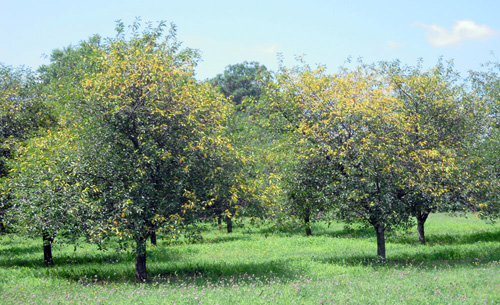
Cherry leaf spot often appears first in the tops of the trees where spray coverage is the
poorest.
Shiro and Vibrant plum harvest is under way. Plums should be protected from brown rot and apple maggots. White apple leafhoppers also attack plum leaves. Watersoaked spots can be seen on some fruit due to bacterial spot infections.
Apples are 2 to 2.5 inches in diameter. Lodi apples are being harvested. Apple scab is defoliating unsprayed trees. Sooty blotch and fly speck diseases are favored by rains and dewy nights. The second generation of oriental fruit moth is laying eggs. Oriental fruit moth biofix was set July 8. Codling moth trap catches are with the second generation’s flight. Codling moth biofix was July 15 in Berrien County and July 18 in Van Buren County. We are about 280 to 180 GGD base 50 from the respective biofixes. Last week we were picking up about 30 GGD every day. Now is the time to treat for the second generation.
Obliquebanded leafroller biofix in southwest Michigan was June 13. Trap catches for the last two weeks have been low and the second generation of obliquebanded leafroller should emerge soon. Apple maggot flies are out. European red mite numbers are building. From mid-July to mid-August, the treatment threshold for European red mites is seven mites per leaf. Heavy populations of green apple aphids on suckers and shoots were observed in Red Delicious.
Pears are 2 inches in diameter. A few pear psylla eggs were observed in the orchards we scout, but populations were generally light. Second generation codling mothis a concern in pears and growers should be treating for this generation.
Small fruit
Japanese beetles are easy to find and are congregating in small fruit plantings.
Grapes are at cluster tightening. Some color has been reported in French hybrid grapes, indicting the beginning of veraison. Grape berry moth trap catches were fairly low this week. Second generation larvae are feeding in the fruit. Japanese beetles feeding in vineyards continues this week. Downy and powdery mildew are the primary disease concerns now. Last week’s hot weather would have inhibited powdery mildew development. No powdery mildew was observed in the vineyards we scout. The daily dews are ideal for downy mildew development. Downy mildew has been found primarily on foliage, with only a little so far on berries.
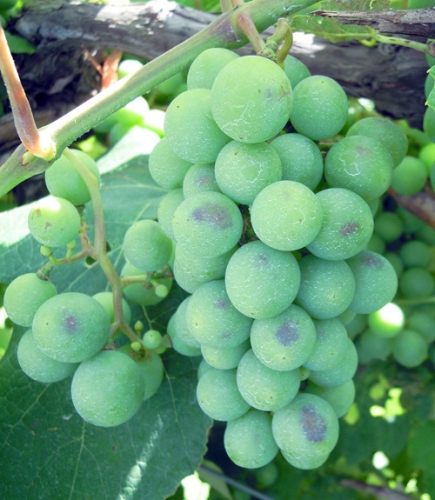
Grape berry moth feeding is apparent as discolored areas below the skin of
the berry.
No major damage from grape leafhoppers and potato leafhoppers has been reported. Gramoxone is being applied to clean up summer weeds under the trellis. Paraquat damage to the lower portion of vines can be easily seen where spray application reached above weed growth.
Blueberries are being harvested across the region. The harvest of Bluecrop is peaking. Early hand-harvest of late, mid-season berries such as Jersey and Nelson is also underway. Growers who can irrigate should be replacing the 0.2 to 0.25 inches of water lost every day. You can stop irrigating after rains, but do not stop and wait for rain.
Spotted wing Drosophila flies were trapped in Allegan County before the really hot weather. No flies were trapped last week. Growers should monitor for this pest. Cane collapse from phomopsis cane blight continues. Insects of concern include Japanese beetles and blueberry maggots. Anthracnose is the most common fruit rot found on ripening fruit
Most strawberry fields are recovering from renovation. Irrigation is very important after renovation to get the strawberries off to a good start. Growers should control potato leafhoppers, which can stunt strawberry growth.
In brambles, harvest of summer bearing red raspberries, black raspberries and blackberry continues. Two-spotted spider mites have been found in raspberries, Growers should protect against Japanese beetles.
Southeast Michigan – Bob Tritten, Michigan State University Extension
|
Weather
We have had quite a spectrum of rain events over the last few weeks across east Michigan. On two occasions we’ve had a line of strong, fast-moving thundershowers move through the region, bringing anywhere from 0.10 to 1 inch of rainfall at many fruit farms. Also scattered between these storm events has been some slower-moving, very narrow pockets of rain showers that have brought some relief from drought to just a few fruit farms. The Thumb has received the most rainfall in the last few weeks. While it is hard to summarize soil moisture conditions with the entire east Michigan region, I would say that for the most part, our soils remain very dry and that signs of drought stress continue to become more evident in not only newly established blocks of tree and small fruits, but also in those that are under other than drought stress or have been planted in just the last few years. Overall growers are spending more and more of their time managing irrigation in fruit plantings. There are a good number of fruit farms that have not received a significant rainfall in the months of June or July. Growers are very hopeful that the rain events predicted for late this week will help to begin to turn things around.
Our season is running almost a week ahead of normal in terms of degree day totals and about five days ahead of normal when we look at the beginning of harvest of some of our fruit crops. The most recent examples of earlier than normal harvest are Japanese plums and early peach varieties.
|
Southeast Michigan Growing Degree Day Totals for March 1 to July 25 |
|||
|
Location |
GDD42 |
GDD45 |
GDD50 |
|
2291 |
1991 |
1533 |
|
|
2224 |
1928 |
1478 |
|
|
Flint (Genesee) |
2296 |
1992 |
1536 |
|
2285 |
1987 |
1532 |
|
|
2436 |
2121 |
1639 |
|
|
2075 |
1787 |
1353 |
|
|
2288 |
1992 |
1540 |
|
Tree fruits
Applescontinue to size fairly well despite dry soils at most farms. Many apple varieties are approaching 2.5 inches in diameter. Where soils are dry, I am already seeing reduced fruit sizes. Harvest of the earliest maturing summer apple varieties is now underway, including Lodi at a few farms. Summer pruning continues at most farms across the region.
With the recent rain events that have moved across the region, the pace of apple maggot trap catch has increased in the last week. I announced the first apple maggot trap catch of the year on July 15. Up until now, their emergence has been rather sporadic and slow. However, with recent moisture at many farms, apple maggot trap catch on both yellow sticky traps and red sphere traps is on the rise. Growers who are relying on trap catch numbers from traps on their farm should use that information to help time their apple maggot cover sprays for the season. For growers who are not trapping for apple maggot on their farm, it is up to the growers discretion in terms of continuing to keep covered for apple maggot.
Codling moth trap catches have started to jump up this week – this is the start of the second generation adult flight. Some growers biofixed for second generation over the weekend. I am finding damaged fruit from codling moth and a few larvae at just a few farms. Where mating disruption is being used, I am seeing a little fruit damage along driveways and areas where pheromone density has a gap or is lacking. Oriental fruit moth trap catches remain about the same across the region. I would expect to see some more continued trap catches over the next week. There are also a few larvae from fruit tree leafrollers and obliquebanded leafrollers. Wooly apple aphid populations continue to slowly build in many blocks of apples. In a few blocks, I am seeing very high numbers of wooly apple aphids and that they have already moved out to the terminal branches. In these situations, some control measures need to be taken.
Potato leafhopper populations seem to be under control in most apple blocks. San Jose scale crawlers are still being seen, although their numbers are reduced. I have seen San Jose scale damaged fruit at a few farms over the last two days. Dogwood borer adults are beginning to fly. European red mite populations continue to build in many blocks of apples. It is difficult to assess the overall mite numbers because they are so variable from tree to tree and row to row. I have seen a few blocks of Honeycrisp where European red mite numbers were high enough to warrant a control measure.
Two-spotted spider mites and apple rust mites continue to feed in apples. However, generally the numbers of these latter two mites are not high enough to warrant control measures. I am seeing a good number of predators, particularly lacewing eggs and larvae. I was also fortunate enough to see a praying mantis yesterday (July 25) feeding on insects and apples.
Powdery mildew symptoms continue to show up in many blocks of apples. Growers are finding that their apple scab control strategies that typically have controlled powdery mildew in the past have not worked so well this year. I continue to see a few fruit infected with cedar apple rust. Lastly, sunburn on fruit is starting to be seen at a few farms, particularly where fruit are exposed to bright sun or where summer pruning was done.
Pears are about 1.75 inches in diameter. There are a few blocks where two-spotted spider mite populations are very high in pears. Also, I am seeing some leaf burning in some blocks where two-spotted spider mite populations are really high. Pear psylla populations are also heavy in a few blocks where they have not been controlled.
Peach harvest has begun for early varieties of peaches. I have heard from a few growers that have seen very high percentages of early peach variety with split pits and therefore cracked fruit. The numbers of fruit affected may be as many as 40 percent of fruit. This is also an opportunity for earwigs to enter the fruit. Where soils have remained dry, peach size is a major issue. Where adequate amounts of soil moisture have been applied, fruit size is good this year. We are a little over a week away from first harvest of Red Haven.
Sweet cherry and tart cherry harvest is completed at all farms across the region. I’ve had a number of reports of growers finding cherry fruit fly maggots in fruit at the end of harvest. A post-harvest insecticide application will help reduce the population of cherry fruit flies for next season. Some growers have been very surprised to see the extent of leaf-yellowing and drop from cherry leaf spot over the last few weeks. Two post-harvest applications of fungicides are needed on these blocks, particularly where defoliation is extensive. I am always fearful that these blocks will have a fair amount of winter damage when we have severe weather this winter.
Plum harvest is underway for Methley and Shiro varieties. Plum size on European or Stanley plum types remains about the same at almost 1 inch in diameter.
Small fruits
Strawberries continue to rebound from the renovation process, particularly where soil moisture has been adequate. Where soils have been dry from lack of rain and no-to-little supplemental irrigation has been applied, strawberries appear to be standing still. Where strawberries are standing still, I would encourage growers to get their irrigation systems back into the field and apply about 1 inch of water a week to get the berries growing again. I have seen several new plantings of strawberries where potato leafhopper populations have caused some leaf curling. Growers need to do a good job of scouting for this pest.
Raspberry harvest continues for summer red and black raspberries, and some farms have opened up for limited harvest on fall red raspberries on fruit from the fruiting lateral canes or bud berries. However, this harvest is rather modest. The main crop of fall red raspberries is currently maturing and for some varieties will begin picking in the next week to 10 days. Potato leafhopper leaf curling has been severe in some blocks of fall red raspberries. Japanese beetle feeding has been particularly heavy in the last week in fall red raspberries. Also, some plantings of fall raspberries have a modest amount of powdery mildew.
Blueberry harvest is in full swing at all farms across the region with several varieties being harvested at this time. Blueberry maggot trap catch has not been reported. I have not had any trap catch of spotted wing Drosophila.
Grapes continue to fill out nicely. French hybrid types are now at berry touch. I have seen a slight peak in the flight of grape berry moth, with a few larvae feeding in fruit clusters. Wild grapes growing in apples have been decimated with high populations of Japanese beetles over the last two weeks. Powdery mildew symptoms are starting to show up in grapes.
Grand Rapids Area Tree Fruit – Amy Irish Brown and Phil Schwallier, Michigan State University Extension
|
Weather summary
Several days of daily highs over 90 and lows near 70 degrees drove degree day accumulations to four to five days ahead of normal for this week in July. There were some rain showers with the heat that helped prevent any obvious water stress in tree fruits. The exception would be newly planted trees, which are starting to show some signs of water stress in some blocks.
Tree fruit diseases
Apple leaves and fruits should be at a stage where their susceptibility to apple scab and fire blight is less for the rest of July and August, so cover sprays are not so critical. If we get a wet September, fungicides will be needed again to prevent fruit scab.
Keep fungicides updated every three to four weeks for summer diseases, or use the model on Enviro-weather to adjust when fungicides are needed based on rainfall and your last date of fungicide application.
Tree fruit insects
A new codling moth biofix is being set for second generation flight that just got started over the past weekend. We have accumulated 52 degree days base 50 since that date of July 23. With the forecasted temperatures, I expect egg hatch to start over the coming weekend (July 30-31).
Obliquebanded leafroller adult flight is over for the summer generation. There are various stages of larvae present and now is the time to do some very close scouting for obliquebanded leafrollers in terminals and clustered fruits. When you see two to three larvae-infested terminals per tree, control sprays are needed. Adults of the overwintering generation should begin to fly at any time – this is a good time to change out lures in your traps.
Japanese beetles continue to be on the increase and they are starting to pair up, which is a good signal to use for timing control sprays. New populations continue to move into tree fruits, especially Honeycrisp, so continue to monitor for this pest.
European red mites can be found in all life stages. Monitor mites closely and don’t wait too long and let populations grow too much before applying a summer miticide. The high temperatures last week and for later this week will continue to increase mite populations.
Wooly apple aphids are getting really high in number in some blocks and will continue to build for the rest of the summer without controls. In blocks with high numbers at harvest, pickers often complain that they stain their hands and clothes. We are at a good timing to still get good control of wooly apple aphids. Be sure to slow down and use a lot of water to fully coat that waxy cottony coating on the wooly aphids.
Oriental fruit moth is most likely at a peak egg hatch for their second generation, so cover sprays in stone fruits are critical for another week to 10 days. Be sure to double check the pre-harvest interval of any pesticides you are using as early peaches will start to be harvested soon.
Grand Rapids Area Small Fruit – Carlos García-Salazar, Michigan State University Extension
|
Weather conditions in the Grand Rapids region during the past seven days continued to be hot and humid, although temperatures only reached the upper 80s and daily average temperatures remained above 70°F. In addition to the heat, we had thunderstorms that produced precipitation, leaving more than 1.5 inches of rain in the area. These conditions are perfect for outbreaks of pests and diseases in most fruit crops. Because of the high temperatures, the growing degree-day accumulation has reached 1485-1500 GDD (base 50°F).
The harvest of summer raspberries has continued with fruit of good quality. Fall raspberries, on the other hand, are in full bloom and it is the time when irrigation is important to have a good crop. For raspberries, the major problems have been Japanese beetles and Lygus bugs (tarnished plant bug). Feeding of tarnished plant bugs in developing berries causes crumbly berry in raspberries. Most damage occurs after petal fall. For Japanese beetles and tarnished plant bugs, apply Assail 30 SG (4 to 5 oz. per acre). This insecticide has a small pre-harvest interval and it will allow continuing harvesting the next day after the application. For organic production, use Pyganic or Neem based insecticides. For more options, please consult MSU Extension Bulletin E-154, Michigan Fruit Management Guide 2011.
Regarding blueberries, the harvest has continued with fruit of decreasing size and quality. The first harvest was of excellent quality, but subsequent fruit has decreased in size. In some cases, growers are irrigating and waiting for the fruit to increase in size before continuing with the harvest. The size of the expected blueberry crop has not materialized in many cases and growers are reporting low yields. Also, the intense heat of the past two weeks started affecting the fruit quality. Another problem affecting not only blueberries, but small fruits in general, is the Japanese beetle.
In contrast to the previous two years, when the Japanese beetle was almost nonexistent as a pest problem, this year the pest has returned, taking growers by surprise. The presence of the beetle is very damaging for the small fruit industry in general because it is becoming a food safety issue for all kinds of berries. The infestation of Japanese beetles has been more problematic for organic growers unable to maintain their crops reasonably free of beetles. In both blueberries and raspberries, the only organic-approved products against Japanese beetles are Pyganic and Neem based insecticides. These products have a low residual effect and multiple applications are required to have an acceptable control. Protection provided by these products is adequate under low Japanese beetle pressure. However, in years like 2011, these products are not very effective and almost daily applications are required to obtain a decent control.
For non-organic growers, Japanese beetle control is less problematic, but it is necessary to maintain a continuous vigilance to eliminate this pest before it becomes a problem. If harvest is already in progress and beetles are creating a food safety concern, you may apply either Aqua Marathon 8 AC (2 to 2.5 pt. per acre) or Mustang Max 0.8EC (4 oz. per acre). These two insecticides can be applied one day before harvest. If the harvest is more than three days away, you may apply Imidan 70 WP (1.33 lb. per acre). For more options, please consult MSU Extension Bulletin E-154, Michigan Fruit Management Guide 2011.
Other insects of concern in blueberries are blueberry maggots and the spotted wing Drosophila. No problems are reported related to blueberry maggots. Regarding the spotted wing Drosophila, we are conducting an extensive survey with apple vinegar traps. So far, only one confirmed detection has been reported in Allegan County. In Kent, Ottawa and Muskegon counties, no spotted wing Drosophila flies have been found. However, we are continuing its monitoring in blueberries and raspberries.
West Central Michigan – Mira Danilovich, Michigan State University Extension
|
Weather
The relentless heat has kept its grip over the area for two weeks now. Currently, the humidity has gone down, providing much needed relief at least for a day or two. The national weather forecast is calling for another temperature and humidity increase from Thursday (July 28) on. Our season has gained some ground in terms of degree-day accumulation. Mason County is still about three days behind normal. In Oceana County, we are seeing a diagonal split going from southwest to northeast with the northern triangle being three days behind normal while the southern triangle shows three days ahead normal. Rainfall is definitely behind normal throughout the district. In the last two weeks, there has been only about 0.25 inches of precipitation. This lack of precipitation has slowed down some of the disease development as well as emergence of cherry fruit fly and apple maggot.
Tree fruit
This area is just finishing up the third week of tart cherry harvest. Historically, this has been one of the peak harvesting weeks. The numbers have not been posted yet, but the reports are showing exceptionally good grades being mainly into the mid- to high 90s. Due to the lack of moisture pretty much throughout the season, cherries are generally smaller, thus firmer and less prone to splitting on contact with the canvas during harvest. Sweet cherries are just about done. Early peaches and plums are nearing harvest. Apples are looking good.
West Central Michigan Growing Degree Day Totals Since March 1
As of Monday, July 26
|
Location |
DD42 |
DD45 |
DD50 |
Rainfall |
|
|
Last 2 weeks |
Since 4/1 |
||||
|
2075 |
1785 |
1345 |
0.28 |
11.70 |
|
|
1970 |
1683 |
1252 |
0.29 |
13.61 |
|
Insects
In Mason County, codling moth numbers, though still above threshold overall, are showing decline for the third week now. The biofix for the second generation is July 2 with 789 DD50. The high temperatures are driving the degree-day accumulation and insect development. The second generation peak egglaying is only a day or two away. Obliquebanded leafroller numbers are up this week. Oriental fruit moth numbers have doubled since last week, confirming the second generation emergence. There is significant increase in trap count in greater peachtree borers, American plum borers and obliquebanded leafrollers.
The first apple maggot catch this season was last week, July 16, in Mason County. This week, scouts did not report any new catches. Rose chafer numbers remain high. With the hot weather, spider mite population is exploding. Calls are starting to come regarding leaf “firing” in cherries. This phenomenon is the result of severe spider mite injury. Japanese beetles are present in many blocks. Tarnished plant bugs are found in peaches. Stink bugs are commonly found throughout the area. Scouts are reporting generally lower populations of aphids throughout the area, though in some blocks the aphid numbers are quite high.
Diseases
This hot weather has not been very conducive to disease development. Apple scab throughout the area is showing low to moderate pressure. Fire blight, shoot blight is mainly present in blocks with history of the problem. Cherry leaf spot is present, but for the most part trees are holding onto their leaves quite well. The weather conditions provided much “kinder” conditions that worked in our favor when combating cherry leaf spot disease. On the other hand, high humidity aided powdery mildew development to the extent that there are symptoms and rusty lesions on the fruit.
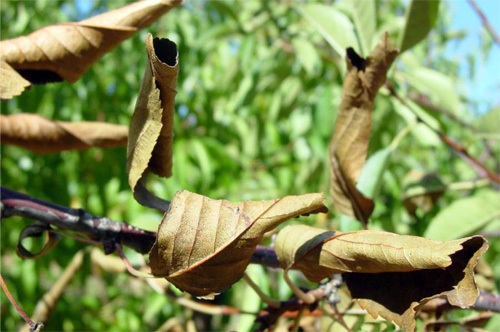
Leaf “firing” in tart cherries caused by heavy mite population enhanced by droughty
conditions.
Northwest Michigan – Nikki Rothwell, Duke Elsner, Erin Lizotte, Michigan State University Extension
|
Weather
Despite our cold, wet spring, we have accumulated growing degree days that are almost spot on with our 21-year average. So far this season, we have accumulated 2001GDD base 42 and our average is 2017GDD base 42. For base 50, we have accumulated 1288GDD this season and the 21-year average is 1269. The temperatures so far this week are much cooler than last week. We hit a few records in the north with the high temperatures and we stayed in the high 80s and low 90s during the day. Nighttime temperatures also were pretty high last week: high 60s and low 70s. Rainfall has been variable across the region. At the Northwest Michigan Horticulture Research Center (NWMHRS), we have not had substantial rain in a few weeks, and we have had only 0.61 inches of rain since June 24. Weather stations north of the NWMHRS had a bit more rainfall, but conditions remain very dry throughout the region.
Crop report
Tart cherry harvest is in full swing here in the north. Quality of the tart cherry crop looks surprisingly good, particularly with the heat last week. In the past, we have observed soft fruit with high temperatures at harvest, but this season, fruit is firm. Cherries are smaller than usual, which is likely due to the lack of rainfall in the past few weeks. Sweet cherry harvest is wrapping up, and the hot and dry temperatures really helped keep disease at bay. Red raspberry harvest has started, and fruit looks good.
Pest report
Apples.Minimal apple scab lesions have been reported around the region, particularly on highly susceptible varieties. Given the warm weather, growers in the north will be keeping an eye out for sooty blotch flyspeck. Sooty blotch flyspeck is more common further south where more moisture is present in the season. Sooty blotch flyspeck is caused by a fungal disease complex (Gloeodes and Leptodontidium and Schizothyrium) of apple in humid fruit-growing regions of the United States. The diseases can cause significant economic losses due to the unsightly appearance of affected fruit. Both pathogens colonize the waxy surface of pome fruit, but do not penetrate lower layers.
Though we have not caught apple maggots at NWMHRS, area scouts are reporting trap catches as early as last week. Apple maggot management should be targeted 7 to 10 days after detection for most insecticides. For more information on apple maggot management, refer to the article Managing apple maggots with insecticides.
Codling moth emergence continues at a slow pace. Second generation codling moth treatment will not begin until approximately 1200 DD50 after first generation sustained catch (though detecting second generation adult biofix and predicting egg hatch is a more accurate gauge of the ideal treatment window for second generation). Growers can track their site-specific progression using the codling moth model on Enviro-weather. Green apple aphid numbers on foliage and fruit have increased with the warm weather and succulent growth of apple. Obliquebanded leafrollers continue to emerge as adults and adult moth trap catches are up again this week after two weeks of minimal activity. Growers can scout for multiple life stages of obliquebanded leafrollers. Adults moths are easily trapped with pheromone-baited delta traps, and larvae or pupae are also likely present at this time in rolled leaves. Growers looking to treat for the summer generation of obliquebanded leafroller larvae can use the obliquebanded leafroller model on Enviro-weather as a reference.
Cherries. Obliquebanded leafroller activity continues in cherry with adults, larvae and pupae present in area orchards. Adult obliquebanded leafroller trap catch was up in most trap sites this week. For growers that were not able to make an application targeting overwintering larvae earlier this season, a second management window is open, but growers should keep in mind the pre-harvest intervals (PHI) of the target materials.
Obliquebanded leafrollers have been observed more commonly in both sweet and tart cherry during the past seasons. These insects are not internal feeders in the fruit, and although they can cause some damage from defoliation, the greater concern is their threat as a contamination pest if they are found in cherry tanks at harvest. Growers with problem orchards risk having tank-loads rejected at the processor if obliquebanded leafroller larvae are present. Organophosphate resistance (and pyrethroid cross-resistance) in obliquebanded leafrollers is likely one of the factors contributing to larvae in cherry tanks at harvest. Fortunately, there are several new insecticides that have been efficacious against summer generation obliquebanded leafroller larvae. Tart and sweet cherry obliquebanded leafroller larvicides include Delegate, Belt, Altacor, Voliam flexi or Entrust. The PHI should be a primary consideration when selecting an insecticide at this point in the season. The larvae have a distinct black head capsule that is slightly flattened. Obliquebanded leafroller larvae vary from light yellow to green and grow to 1 inch. Growers can also monitor for the adult moths using pheromone baited stick traps. Treatments should be applied if average trap catches approach or exceed 20 moths per trap or two to three active larvae per tree are observed.
Plum curculio activity is surprisingly continuing with adults back in the traps this week. Second generation American plum borer emergence continues – delineating between generations can be difficult as trap catches often never stop completely. However, as trap numbers begin to climb, the increased catch of moths indicate the flush of second generation emergence will likely occur in the coming weeks. Lesser peach tree borer emergence has rebounded with an average of three per trap. Peach tree borer numbers also continued to rise this week.
The first cherry fruit flies of the season were detected in the NWMHRS trap line on July 5. Positive trap catches have continued since and may growers will be applying post-harvest sprays in the coming weeks. Numbers were up again this week with more than 80 flies caught in some trap locations. Cherry fruit flies emerge for about a month, with peak emergence in late June and into early July. Seven to 10 days after emergence, females deposit eggs in the fruit where hatching larvae immediately burrow in and feed. Most control strategies employ insecticides that target the adult stage during that 7- to 10-day window with subsequent applications as needed. If flies are trapped on-farm, but a regional trap catch was recorded earlier, the treatment should be timed based on the earlier regional capture to minimize the risk of larvae in the fruit. However, because population size influences trap catch, it is critically important that growers monitor their own farms for cherry fruit flies to help predict population size as well as duration of activity. Larvae mature in the fruit and then drop to the soil where they enter the ground, pupate and start the next generation’s life cycle the following season.
Recent work has shown that a great deal of cherry fruit fly activity occurs after harvest and this pest behavior provides a post-harvest opportunity for management in sites with high populations. Preliminary research has shown that imidacloprid products, such as Prey and Pravado work well at the post-harvest application timing seven days after harvest. This spray could be tank-mixed with the post-harvest chlorothalonil application for cherry leaf spot. Refer to MSU Extension Bulletin E-154 Fruit Management Guide for more information and always carefully read and follow pesticide labels.
Black cherry aphids are also visible in significant numbers on the terminals of sweet cherry branches. Black cherry aphid feeding curls and stunts leaves and deforms shoot growth. Highly susceptible varieties include Black Tartarian, Napoleon, Schmidt and Windsor. Young cherry trees are especially susceptible to injury and can be killed if infestations are heavy. Severe infestations may also reduce the quantity and quality of the crop on mature trees. Overwintering black cherry aphids eggs hatch as cherry buds begin to open in April. Two to three generations are usually completed on cherry. Several summer generations are produced on alternate hosts, with winged adults returning to cherry orchards in September and October to mate and lay overwintering eggs. There are a number of effective insecticides for the management of black cherry aphids in sweet and tart cherry, including Provado, Actara, Assail, Beleaf, Vloiam flexi, Movento, Voliam flexi and Leverage (management may be delayed until postharvest). As we approach harvest, growers should be aware of the PHIs of various materials and always read and follow pesticide labels carefully.
The potential for epidemic levels of cherry leaf spot remains a concern this season. We began seeing significant cherry leaf spot infections early this season and defoliation is already underway in some blocks, particularly those with foliar bacterial canker infections from this spring. Growers should look closely to determine if it is cherry leaf spot, bacterial canker, virus or phytotoxicity causing defoliation as all are present this season. Cherry leaf spot is resistant to sterol inhibitor fungicides (Indar, Elite, Orbit) in all the major fruit producing areas of Michigan. As cover treatments are applied, remember to alternate the use of fungicide classes and tank-mix dodine and strobilurin fungicides with a full rate of Captan to manage against resistance development. Under cool conditions, copper is an excellent cherry leaf spot material and a good strategy for resistance management; copper rates of 1.2 lbs. metallic copper are recommended. Lime is also recommended as a safener for copper applications, but Imidan cannot be used in this tank-mix due to changes in pH.
Early bacterial canker symptoms allowed American brown rot infections to become established on green fruit early and hail damage and sites with a history of American brown rot are also at risk at this time with weather conditions highly favorable for disease development. Indar should be applied at a 6 fl oz/A rate. An 8 fl oz/A application rate should only be used if a shift in fungal sensitivity is suspected (only Indar 2F is labeled for increased rates). Surfactants, high water application volumes, full covers and slow speeds are important strategies for American brown rot management. Growers looking to treat for cherry leaf spot and hedge their bets against American brown rot could utilize Pristine at this time.
Grapes. The crop load looks very good in most northwest vineyards. Abnormally hot weather has pushed vines along quickly. Berry growth has been rapid and tight clustered cultivars are well past berry touch. Some growers have started to hedge vines, which has resulted in many lateral shoots already. It looks like we’ll have another year with a need for several rounds of hedging. Powdery mildew was not seen on leaves or berries of any cultivars at NWMHRS on July 25. Five other Leelanau County vineyards visited on the same day also showed no powdery mildew. A private scout reported seeing just a little powdery mildew in a few Old Mission vineyards.
Grape berry moth is the primary insect pest at this time, as adult flight and egglaying activity continues. Potato leafhopper pressure is still light in treated vineyards and really not very significant on the unsprayed vines at NWMHRS. The first adult Japanese beetles were seen on July 25. Hornworm larvae are over one inch in length and beginning to feed rapidly. These are of little concern in established vineyards, but they can be very serious defoliators in young vines.
Weed growth under the trellis has been quite a problem in some vineyards this year, probably due to heavy spring rains reducing herbicide residues at the soil surface.
Saskatoons. Fruit is ripening and harvest should be underway. There have been a few reports of rust fungus infections to leaves, stems and berries in the last two weeks.



 Print
Print Email
Email